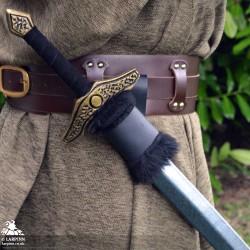LARP weapon safety is incredibly important, but its also a very controversial topic and can be an intimidating...
Search in blog
Latest posts
-
 Things to Know Before Your First LARP Event2022-10-14Posted in: Blog Posts & Articles2125 views 21 LikedRead more
Things to Know Before Your First LARP Event2022-10-14Posted in: Blog Posts & Articles2125 views 21 LikedRead moreThis year we’ve been asking customers in store and online ‘What is one thing you wish you had known before you first...
-
 Warhammer 40,000 - Telford, Shropshire, West Midlands2024-06-061082 views 1 LikedRead more
Warhammer 40,000 - Telford, Shropshire, West Midlands2024-06-061082 views 1 LikedRead moreIn our games room above our LARP shop, we stock and host Warhammer 40,000 alongside many other table-top wargames and...
-
 Christmas Return Policy2023-11-07Posted in: Blog Posts & Articles1333 views 0 LikedRead more
Christmas Return Policy2023-11-07Posted in: Blog Posts & Articles1333 views 0 LikedRead moreFor the holiday season we're extending our return window to allow customers to buy gifts with enough time for...
-
 Do I Need a Right-Hand or Left-Hand Scabbard?2023-09-13Posted in: Blog Posts & Articles1980 views 0 LikedRead more
Do I Need a Right-Hand or Left-Hand Scabbard?2023-09-13Posted in: Blog Posts & Articles1980 views 0 LikedRead moreLots of customers get themselves confused as to which side their scabbard should sit for their sword. We get it! It's...
-
 LARP Weapon Safety2023-01-193739 views 0 LikedRead more
LARP Weapon Safety2023-01-193739 views 0 LikedRead moreLARP weapon safety is incredibly important, but its also a very controversial topic and can be an intimidating...
-
 Things to Know Before Your First LARP Event2022-10-14Posted in: Blog Posts & Articles2125 views 21 LikedRead more
Things to Know Before Your First LARP Event2022-10-14Posted in: Blog Posts & Articles2125 views 21 LikedRead moreThis year we’ve been asking customers in store and online ‘What is one thing you wish you had known before you first...
-
 Warhammer 40,000 - Telford, Shropshire, West Midlands2024-06-061082 views 1 LikedRead more
Warhammer 40,000 - Telford, Shropshire, West Midlands2024-06-061082 views 1 LikedRead moreIn our games room above our LARP shop, we stock and host Warhammer 40,000 alongside many other table-top wargames and...
-
 Christmas Return Policy2023-11-07Posted in: Blog Posts & Articles1333 views 0 LikedRead more
Christmas Return Policy2023-11-07Posted in: Blog Posts & Articles1333 views 0 LikedRead moreFor the holiday season we're extending our return window to allow customers to buy gifts with enough time for...
Popular posts
-
 LARP Weapon Safety2023-01-193739 views 0 LikedLARP weapon safety is incredibly important, but its also a very controversial topic and can be an intimidating...Read more
LARP Weapon Safety2023-01-193739 views 0 LikedLARP weapon safety is incredibly important, but its also a very controversial topic and can be an intimidating...Read more -
 How to Apply Prosthetic Ear Tips & Other Latex Prosthetics2022-03-17Posted in: Blog Posts & Articles3312 views 0 LikedApply latex prosthetics is really easy when you know what you are doing. Follow these easy steps to get to grips with...Read more
How to Apply Prosthetic Ear Tips & Other Latex Prosthetics2022-03-17Posted in: Blog Posts & Articles3312 views 0 LikedApply latex prosthetics is really easy when you know what you are doing. Follow these easy steps to get to grips with...Read more -
 Dungeons & Dragons - Telford, Shropshire, West Midlands2021-10-08Posted in: Gaming5356 views 0 LikedHere at Larp Inn, we've built a wonderful little community around Dungeons & Dragons. Come get all the essentials...Read more
Dungeons & Dragons - Telford, Shropshire, West Midlands2021-10-08Posted in: Gaming5356 views 0 LikedHere at Larp Inn, we've built a wonderful little community around Dungeons & Dragons. Come get all the essentials...Read more -
 LARP Essentials - What to Bring - Packing List2021-03-16Posted in: Blog Posts & Articles5223 views 1 LikedHere at Larp Inn, we know how chaotic packing for an event can be. After many incidents where important items have...Read more
LARP Essentials - What to Bring - Packing List2021-03-16Posted in: Blog Posts & Articles5223 views 1 LikedHere at Larp Inn, we know how chaotic packing for an event can be. After many incidents where important items have...Read more -
 Latex LARP Weapon Maintenance, Storage & Repairs2021-02-23Posted in: Maintenance & Repairs4683 views 1 LikedLets be honest, even the best weapons don't last forever. Good maintenance, storage and regular saftey checks are...Read more
Latex LARP Weapon Maintenance, Storage & Repairs2021-02-23Posted in: Maintenance & Repairs4683 views 1 LikedLets be honest, even the best weapons don't last forever. Good maintenance, storage and regular saftey checks are...Read more -
 LARP Weapon Safety2023-01-193739 views 0 LikedLARP weapon safety is incredibly important, but its also a very controversial topic and can be an intimidating...Read more
LARP Weapon Safety2023-01-193739 views 0 LikedLARP weapon safety is incredibly important, but its also a very controversial topic and can be an intimidating...Read more -
 How to Apply Prosthetic Ear Tips & Other Latex Prosthetics2022-03-17Posted in: Blog Posts & Articles3312 views 0 LikedApply latex prosthetics is really easy when you know what you are doing. Follow these easy steps to get to grips with...Read more
How to Apply Prosthetic Ear Tips & Other Latex Prosthetics2022-03-17Posted in: Blog Posts & Articles3312 views 0 LikedApply latex prosthetics is really easy when you know what you are doing. Follow these easy steps to get to grips with...Read more -
 Dungeons & Dragons - Telford, Shropshire, West Midlands2021-10-08Posted in: Gaming5356 views 0 LikedHere at Larp Inn, we've built a wonderful little community around Dungeons & Dragons. Come get all the essentials...Read more
Dungeons & Dragons - Telford, Shropshire, West Midlands2021-10-08Posted in: Gaming5356 views 0 LikedHere at Larp Inn, we've built a wonderful little community around Dungeons & Dragons. Come get all the essentials...Read more -
 LARP Essentials - What to Bring - Packing List2021-03-16Posted in: Blog Posts & Articles5223 views 1 LikedHere at Larp Inn, we know how chaotic packing for an event can be. After many incidents where important items have...Read more
LARP Essentials - What to Bring - Packing List2021-03-16Posted in: Blog Posts & Articles5223 views 1 LikedHere at Larp Inn, we know how chaotic packing for an event can be. After many incidents where important items have...Read more
Featured posts
-
 LARP Weapon Safety2023-01-193739 views 0 LikedLARP weapon safety is incredibly important, but its also a very controversial topic and can be an intimidating...Read more
LARP Weapon Safety2023-01-193739 views 0 LikedLARP weapon safety is incredibly important, but its also a very controversial topic and can be an intimidating...Read more -
 Things to Know Before Your First LARP Event2022-10-14Posted in: Blog Posts & Articles2125 views 21 LikedThis year we’ve been asking customers in store and online ‘What is one thing you wish you had known before you first...Read more
Things to Know Before Your First LARP Event2022-10-14Posted in: Blog Posts & Articles2125 views 21 LikedThis year we’ve been asking customers in store and online ‘What is one thing you wish you had known before you first...Read more -
 Warhammer 40,000 - Telford, Shropshire, West Midlands2024-06-061082 views 1 LikedIn our games room above our LARP shop, we stock and host Warhammer 40,000 alongside many other table-top wargames and...Read more
Warhammer 40,000 - Telford, Shropshire, West Midlands2024-06-061082 views 1 LikedIn our games room above our LARP shop, we stock and host Warhammer 40,000 alongside many other table-top wargames and...Read more -
 Christmas Return Policy2023-11-07Posted in: Blog Posts & Articles1333 views 0 LikedFor the holiday season we're extending our return window to allow customers to buy gifts with enough time for...Read more
Christmas Return Policy2023-11-07Posted in: Blog Posts & Articles1333 views 0 LikedFor the holiday season we're extending our return window to allow customers to buy gifts with enough time for...Read more -
 Do I Need a Right-Hand or Left-Hand Scabbard?2023-09-13Posted in: Blog Posts & Articles1980 views 0 LikedLots of customers get themselves confused as to which side their scabbard should sit for their sword. We get it! It's...Read more
Do I Need a Right-Hand or Left-Hand Scabbard?2023-09-13Posted in: Blog Posts & Articles1980 views 0 LikedLots of customers get themselves confused as to which side their scabbard should sit for their sword. We get it! It's...Read more -
 LARP Weapon Safety2023-01-193739 views 0 LikedLARP weapon safety is incredibly important, but its also a very controversial topic and can be an intimidating...Read more
LARP Weapon Safety2023-01-193739 views 0 LikedLARP weapon safety is incredibly important, but its also a very controversial topic and can be an intimidating...Read more -
 Things to Know Before Your First LARP Event2022-10-14Posted in: Blog Posts & Articles2125 views 21 LikedThis year we’ve been asking customers in store and online ‘What is one thing you wish you had known before you first...Read more
Things to Know Before Your First LARP Event2022-10-14Posted in: Blog Posts & Articles2125 views 21 LikedThis year we’ve been asking customers in store and online ‘What is one thing you wish you had known before you first...Read more -
 Warhammer 40,000 - Telford, Shropshire, West Midlands2024-06-061082 views 1 LikedIn our games room above our LARP shop, we stock and host Warhammer 40,000 alongside many other table-top wargames and...Read more
Warhammer 40,000 - Telford, Shropshire, West Midlands2024-06-061082 views 1 LikedIn our games room above our LARP shop, we stock and host Warhammer 40,000 alongside many other table-top wargames and...Read more -
 Christmas Return Policy2023-11-07Posted in: Blog Posts & Articles1333 views 0 LikedFor the holiday season we're extending our return window to allow customers to buy gifts with enough time for...Read more
Christmas Return Policy2023-11-07Posted in: Blog Posts & Articles1333 views 0 LikedFor the holiday season we're extending our return window to allow customers to buy gifts with enough time for...Read more

































Top authors